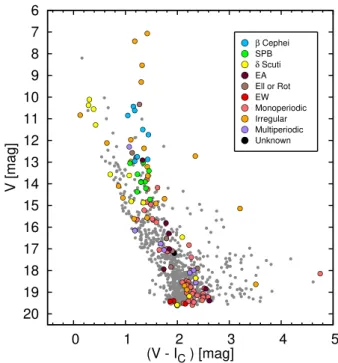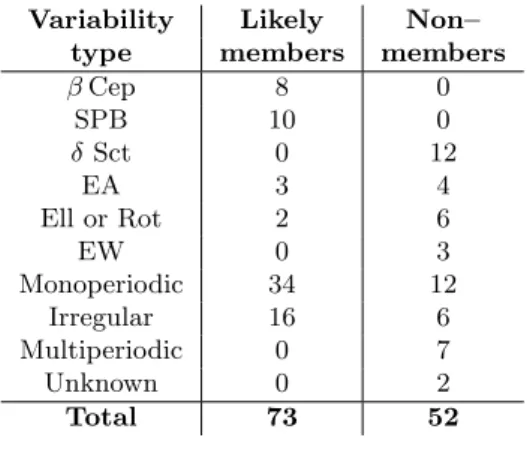Variability survey in NGC 6910, the open
cluster rich in β Cephei-type stars
Dawid Mo´zdzierski1, Andrzej Pigulski1, Zbigniew Ko laczkowski1·2,
Gabriela Michalska1, Grzegorz Kopacki1, Artur Narwid1, Marek St
,
e´slicki3,
Ewa Zahajkiewicz1, Jianning Fu4, Xiaojun Jiang5, Chao Zhang4,
Jason Jackiewicz6, John Telting7, Thierry Morel8, Piotr ´Sr´odka1,
Przemys law Bru´s1and Fabien Carrier9
1. Astronomical Institute, University of Wroc law, Kopernika 11, 51–622 Wroc law, Poland
2. Nicolaus Copernicus Astronomical Center Polish Academy of Sciences, Bartycka 18, 00–716 Warszawa, Poland 3. Space Research Centre, Polish Academy of Sciences, Kopernika 11, 51-622 Wroc law, Poland
4. Department of Astronomy, Beijing Normal University, Beijing, China
5. National Astronomical Observatories, Chinese Academy of Sciences, Beijing, China 6. New Mexico State University, Las Cruces, NM, USA
7. Nordic Optical Telescope, La Palma, Spain
8. Institut d’Astrophysique et de G´eophysique, Universit´e de Li`ege, Li`ege, Belgium 9. Katholieke Universiteit Leuven, Instituut voor Sterrenkunde, Leuven, Belgium
NGC 6910 is the northern hemisphere open cluster known to be rich in β
Cephei-type stars. Using four-season photometry obtained in Bia lk´ow (Poland) and
Xinglong (China) observatories, we performed variability survey of NGC 6910. As the result, we found over 100 variable stars in the field of the cluster, including many stars showing variability due to pulsations and binarity. Thanks to the spectroscopic observations, we also detected changes in the profiles of spectral lines of β Cep stars, caused by pulsations.
1 Introduction
NGC 6910 is the young open cluster containing many β Cep-type variables (Ko lacz-kowski et al., 2004). Preliminary results of the variability search based on photo-metric data obtained during the international observational campaign allowed to detect eight β Cep-type members (Pigulski, 2008; Saesen et al., 2010). Interestingly, it turned out that the frequency spectra of these β Cep stars, arranged according to the decreasing brightness (i.e. mass) showed a progression of frequencies of the excited modes (Pigulski, 2008). This result raised hope for a successful ensemble asteroseismology in this cluster (Saesen et al., 2010). In the present paper, we show preliminary results of the full variability survey of NGC 6910 based on the part of the data obtained during the international observational campaign in the years 2005 – 2007 and 2013. The full results will be published elsewhere.
2 Observations and Results
We used only Bia lk´ow (Poland) and Xinglong (China) photometric data, the two most numerous data samples. Bia lk´ow observations were carried out with a 60–cm reflecting telescope and the attached CCD camera covering 130× 120 field of view
(FoV). Xinglong data were carried out with 50 and 100–cm reflecting telescopes, and CCD cameras covering, 10.5 × 100 .4 and 110 .2 × 110 .2 FoV, respectively. In total, about0 23 500 CCD frames were acquired through the B, V , R, ICbands and narrow–band
Dawid Mo´zdzierski, et al. 6 7 8 9 10 11 12 13 14 15 16 17 18 19 20 0 1 2 3 4 5 β Cephei SPB δ Scuti EA Ell or Rot EW Monoperiodic Irregular Multiperiodic Unknown V [mag] (V - IC ) [mag]
Fig. 1: Colour–magnitude diagram for NGC 6910 open cluster. Variable stars are marked by coloured circles.
Hα filters during 157 nights in these two sites. We also carried out spectroscopic echelle observations with the 2.56–m Nordic Optical Telescope, 1.93–m telescope of Haute–Provence Observatory and Apache Point Observatory 3.5–m Astrophysical Research Consortium telescope in 2007 and 2013.
Photometric observations allowed us to detect 125 variable stars in the field of NGC 6910 open cluster, of which 117 are new (Fig. 1, Tab. 1). Thanks to the large difference in longitude between both observatories, we were able to reduce significantly the daily aliases in the frequency spectra. One of the most interesting results is the mentioned earlier progression of the frequencies for β Cep stars, up to almost 13 d−1 in NGC6910-38. We also detected changes of amplitudes of some
modes in two β Cep stars, NGC6910-16 and NGC6910-27 between 2005 – 2007 and 2013.
Thanks to the spectroscopic observations we have found well pronounced variabil-ity of spectral line profiles caused by pulsations for two β Cep stars: NGC6910-14 and NGC6910-18. We will use this information to identify the degrees l and azimuthal or-ders m of the strongest modes using methods of Zima (2006), Daszy´nska-Daszkiewicz et al. (2005) and Daszy´nska-Daszkiewicz & Walczak (2009).
Acknowledgements. This work was supported by the Polish National Science Center grants No. 2016/21/B/ST9/ 01126, No. 2012/05/N/ST9/03898 and has received funding from the European Community’s Seventh Framework Programme (FP7/2007-2013) under grant agreement no. 269194. This research has made use of the WEBDA database, operated at
Variability survey in NGC 6910
Table 1: Variable stars in the observed FoV and probable NGC 6910 membership.
Variability Likely Non–
type members members
β Cep 8 0 SPB 10 0 δ Sct 0 12 EA 3 4 Ell or Rot 2 6 EW 0 3 Monoperiodic 34 12 Irregular 16 6 Multiperiodic 0 7 Unknown 0 2 Total 73 52
the Department of Theoretical Physics and Astrophysics of the Masaryk University. References
Daszy´nska-Daszkiewicz, J., Dziembowski, W. A., Pamyatnykh, A. A., A&A 441, 641 (2005)
Daszy´nska-Daszkiewicz, J., Walczak, P., MNRAS 398, 1961 (2009)
Ko laczkowski, Z., Pigulski, A., Kopacki, G., Michalska, G., Acta Astron. 54, 33 (2004) Pigulski, A., Journal of Physics Conference Series 118, 1, 012011 (2008)
Saesen, S., et al., Astronomische Nachrichten 331, 1080 (2010) Zima, W., A&A 455, 227 (2006)

